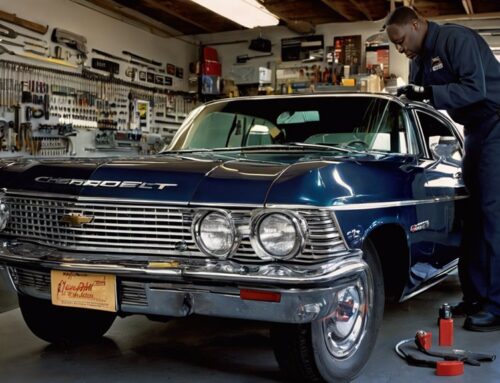When your car key refuses to turn, first check the steering wheel lock. Gently turn the wheel side to side while attempting to turn the key. If this doesn’t work, try lubricating the ignition lock with a silicone-based spray. Insert and wiggle the key to distribute the lubricant evenly. Lastly, make sure your car is in park or neutral and verify the battery charge. These steps help align internal components for a smooth key turn. For a thorough solution that keeps future issues at bay and explores why these steps are essential, keep on to learn more.
Key Takeaways
- Ensure the steering wheel is not locked by gently turning it left and right while trying to turn the key.
- Verify the gear shift is in park or neutral, as modern vehicles require this for the key to turn.
- Use a silicone-based lubricant in the ignition lock to reduce friction and allow smoother key movement.
- Gently wiggle the key inside the lock to align the tumblers without applying excessive force.
- Check the car battery charge, as a low battery can prevent the key from turning in the ignition.
Understanding Car Key Mechanics
Understanding how your car key interacts with the ignition system is important for diagnosing why it might refuse to turn. Your car key is designed symmetrically, allowing easy insertion and enabling it to engage the ignition tumblers correctly. When you insert the key, it aligns with these tumblers in a specific arrangement, which is vital for the ignition system to function properly.
Once the tumblers are correctly aligned, turning the key activates a circuit that provides power to the starter motor. This circuit is managed by a computer chip embedded in the key, guaranteeing the engine starts smoothly. By turning the key, you complete this circuit, allowing the current to flow and initiating the engine start.
If your car key refuses to turn, it might be due to issues with this precise alignment or the mechanics of the key itself. Understanding the shape and mechanics of your car key helps in troubleshooting these problems. Confirm the key is not worn out or damaged and that it aligns correctly with the ignition tumblers. This knowledge is vital for resolving issues and getting your car back on the road.
Identifying Steering Wheel Lock Issues
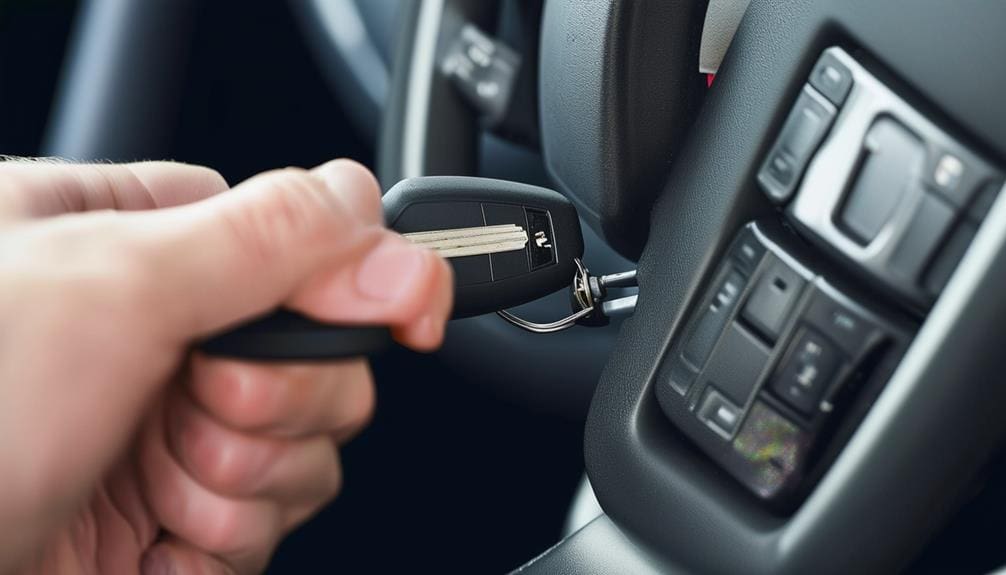
To identify steering wheel lock issues, check if the wheel is misaligned when your key won’t turn. Gently turn the steering wheel left and right while trying to turn the key to release the lock. For a quick release, rock the wheel back and forth to free the mechanism and allow smooth key operation.
Common Lock Mechanism Issues
Encountering a steering wheel lock issue often happens when the wheel is turned slightly as the car is parked, causing the lock mechanism to engage and prevent the key from turning. This can be frustrating, but understanding the problem is the first step to solving it.
First, recognize that the steering wheel lock is a safety feature designed to prevent the vehicle from moving if the ignition is off. When the steering wheels are turned just a bit before shutting off the car, the lock mechanism can engage, blocking key rotation.
To resolve this, insert your key and apply gentle pressure. Simultaneously, try turning the steering wheel left and right. This action helps realign the lock mechanism. You might feel the wheel give slightly, and that’s your cue to turn the key. Once the lock releases, the key should turn smoothly.
Preventing this issue is also straightforward. Before turning off your car, make sure the wheels are straight. This simple step can save you from future headaches. Understanding how your steering lock works and taking preventive measures can keep you from getting stuck with a non-turning key.
Quick Release Techniques
Let’s explore some quick release techniques to easily identify and resolve steering wheel lock issues. When your car keys refuse to turn, it’s often because the steering wheel lock has engaged. This typically happens when the wheel isn’t straight. Here’s how you can address it:
First, insert your car key into the ignition. Apply gentle pressure on the key as if you’re trying to turn it. At the same time, gently wiggle the steering wheel back and forth. This coordinated movement can release the lock mechanism. You’ll feel the steering wheel give way, and the key will turn, allowing the car to start.
To prevent future lock issues, always verify your wheels are aligned straight before turning off the car. This small step can save you from unexpected lock situations. Additionally, regularly check the steering wheel position before exiting your vehicle.
Techniques to Free a Stuck Key
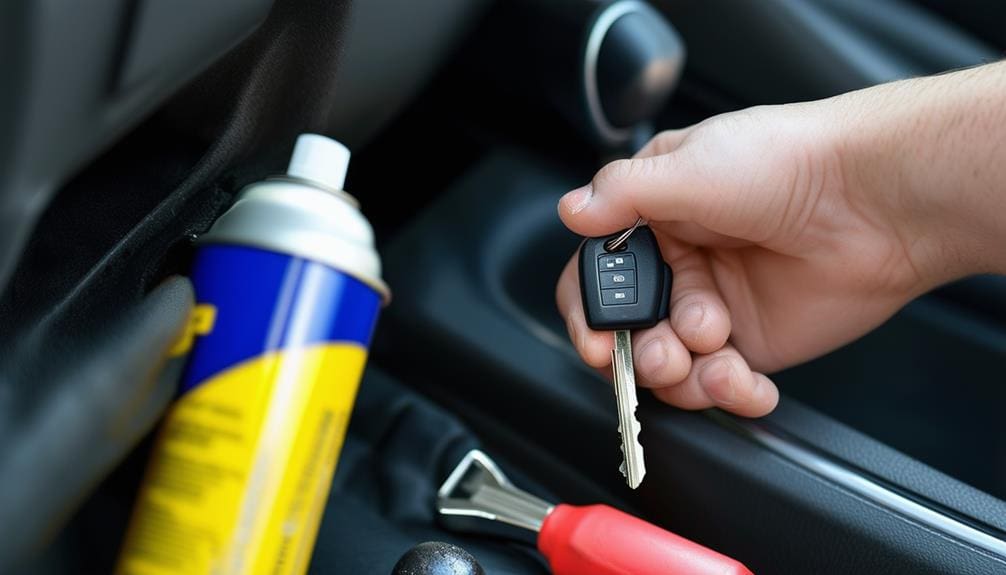
To free a stuck key, start by gently wiggling it inside the lock to engage the current and loosen any obstructions. Make certain not to apply excessive force, as this could damage the lock mechanism. Focus solely on the key, avoiding any movements of the steering wheel to guarantee you’re targeting the lock directly.
Gentle Key Wiggling
Gently wiggling your key inside the ignition can align the tumblers and clear any minor obstructions, making it a simple yet effective way to free a stuck key. Start by inserting the key fully into the ignition. Without applying excessive force, gently wiggle the key back and forth. This motion can help dislodge any debris or minor obstructions preventing the key from turning.
As you perform key wiggling, focus on small, controlled movements. Avoid turning the steering wheel during this process, as it can distract from addressing the lock mechanism itself. The goal is to feel for slight changes in resistance, indicating that the tumblers are beginning to align correctly.
If you encounter resistance, stop and remove the key, then reinsert it and try again. Repeating this gentle wiggling technique can gradually align the tumblers, allowing the key to turn smoothly. Remember, patience is essential. Rushing or using too much force can damage the lock, making the situation worse.
Avoid Excessive Force
Applying excessive force when attempting to turn a stuck key can result in damaging both the key and the ignition system, so it’s crucial to use measured techniques to resolve the issue safely. Instead of resorting to brute strength, follow these steps to free your key without causing further harm.
First, confirm the key is fully inserted into the ignition. A partially inserted key might not align correctly with the lock wafers, making it challenging to turn the key. If the key is fully inserted and still stuck, avoid turning the key forcefully. Instead, try gently wiggling the key back and forth. This technique may help dislodge any minor obstructions inside the lock cylinder.
Here are some important points to remember:
- Insert Fully: Confirm the key is fully inserted before attempting to turn it.
- Gentle Wiggles: Use soft, controlled movements to realign the lock wafers.
- Avoid Steering: Keep clear of touching the steering wheel to concentrate on the lock mechanism.
- Patience: Take your time; rushing can lead to mistakes.
Wiggle Without Steering
When faced with a stuck key, start by wiggling the key gently while ensuring your hands are clear of the steering wheel, which can prevent the lock mechanism from engaging further. This technique targets minor obstructions within the car key lock that may be hindering movement. Begin by inserting the car key fully into the ignition. Next, apply light, controlled pressure while gently jiggling the key back and forth.
Avoid excessive force; the goal is to realign any misaligned lock wafers. Misalignment is often the culprit behind a stuck key, and a gentle wiggle can prompt these wafers to move back into their proper positions. By doing so, you may enable the current flow within the ignition system, which is essential for the key to turn smoothly.
Lubricating the Ignition Lock
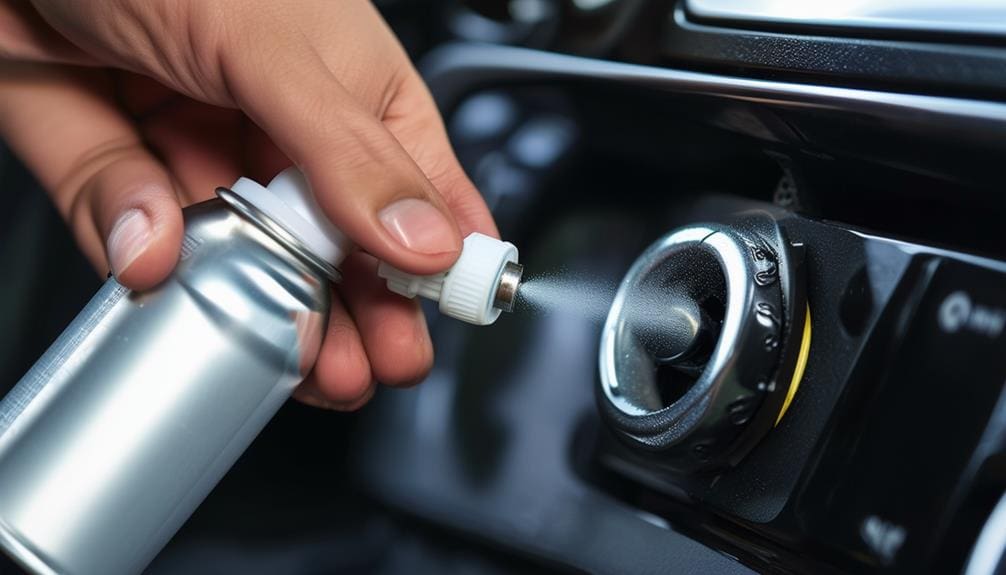
To effectively address a key that refuses to turn, start by lubricating the ignition lock to release any dirt particles hindering the key’s movement. The ignition systems in cars often suffer from dirt and grime buildup, which can obstruct the key’s entry and rotation.
First, choose a silicone-based lubricant as it prevents future dirt buildup. Here’s how to apply it:
- Spray the lubricant: Insert the nozzle of the spray can into the ignition lock and give it a few short bursts.
- Wipe away excess: Use a clean cloth to wipe away any excess lubricant around the lock to avoid attracting more dirt.
- Insert and wiggle the key: After applying the lubricant, insert your key into the ignition lock and gently wiggle it back and forth to help distribute the lubricant and free up the mechanism.
- Repeat if necessary: If the key still doesn’t turn smoothly, add a bit more lubricant and repeat the process.
Checking Gear Shift and Battery
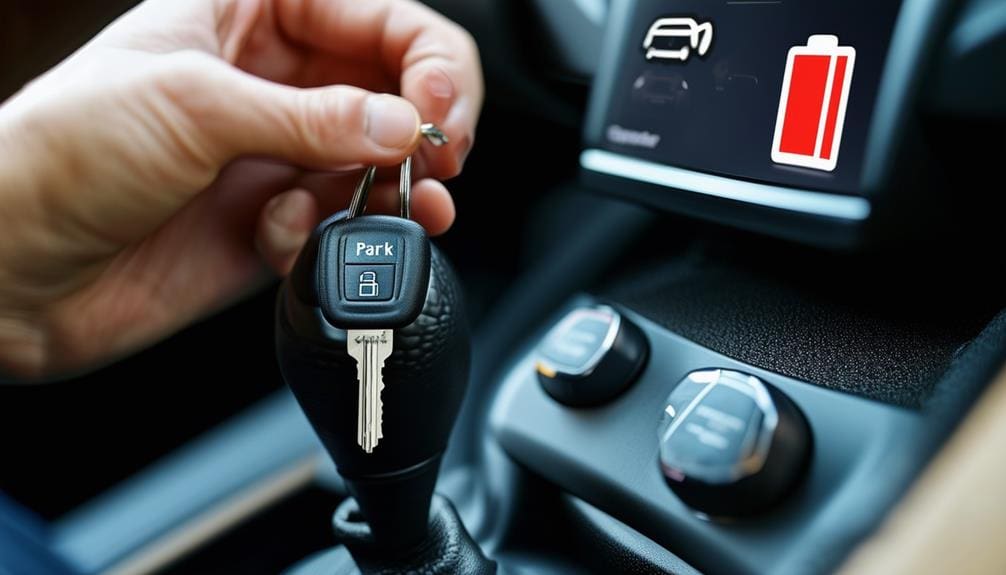
Before diving into more complex solutions, make certain your gear shift is in park or neutral and check whether the car battery has sufficient charge to allow the key to turn. Modern vehicles require the gear shift to be in the correct position before the key will turn. Verify that the gear shift is securely in park (for automatic transmissions) or neutral (for manual transmissions). This simple step can often resolve the issue immediately.
Next, examine the car battery. A dead or weak car battery can prevent the key from turning. Open the hood and locate the battery. Check the battery terminals for any corrosion or loose connections. If you see any, clean them with a wire brush and confirm they are tightly connected. Use a multimeter to measure the battery voltage; it should read around 12.6 volts when fully charged. If the voltage is low, you may need to recharge the battery or jump-start the car.
Preventing Future Key Problems
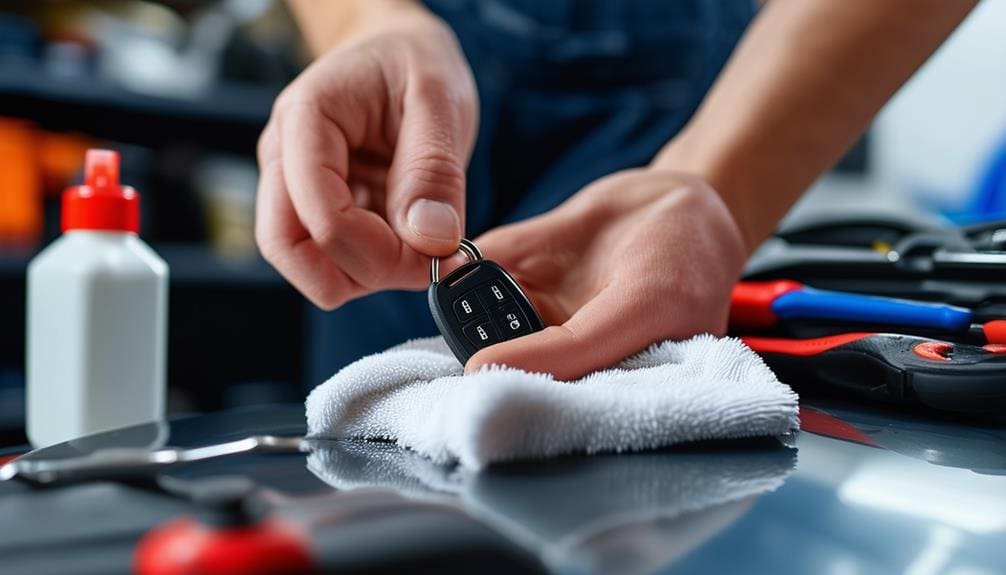
After ensuring your gear shift is in the correct position and the battery is charged, focus on preventing future key turning problems by regularly checking the alignment of your steering wheel before turning off the engine. This proactive step helps minimize the occurrence of the steering wheel_lock mechanism engaging and causing key issues.
To prevent future key problems, follow these practical steps:
- Park with Straight Wheels: Make sure your wheels are straight when parking. This reduces the chances of the steering wheel lock affecting your key.
- Align the Steering Wheel: Before you remove the key, turn the steering wheel to its straight position. This simple action helps avoid triggering the steering wheel_lock mechanism.
- Routine Inspections: Regularly inspect your steering wheel position. A quick check can save you from unexpected key turning problems.
- Mindful Habits: Develop a habit of being mindful about your wheel’s position every time you park. Consistency is key to preventing future issues.
When to Call a Locksmith

If your car key still refuses to turn despite trying multiple DIY solutions, it’s time to contact a professional locksmith. Locksmiths are trained professionals specializing in lock and key issues, making them your best option when at-home fixes don’t work. Here’s why and when you should reach out to them.
First, locksmiths possess the expertise and specialized tools to handle various lock and key problems efficiently. Attempting further DIY methods could risk damaging your car’s ignition system, leading to more costly repairs. Instead, contacting a locksmith guarantees the issue is addressed correctly and promptly.
Secondly, locksmiths offer a significant time-saving advantage. While you might spend hours troubleshooting, a locksmith can often identify and resolve the problem quickly. This efficiency can be particularly vital if you’re stuck in a time-sensitive situation.
Lastly, locksmith services are available 24/7, providing essential assistance during emergencies. Whether it’s late at night or during a busy workday, you can contact a locksmith for immediate help, making sure you’re not stranded for long.
Frequently Asked Questions
What to Do When Your Key Won’t Twist?
First, gently jiggle the key while applying light pressure. Avoid forcing it. Check if the steering wheel is locked and move it slightly. Apply silicone-based lubricant. If the key still won’t turn, consider key extraction or professional help.
What to Do if Car Key Is Not Rotating?
If your car key isn’t rotating, try key lubrication with a silicone-based product. Confirm the steering wheel isn’t locked and rock it gently. Check the gear and apply gentle pressure while wiggling the key to free obstructions.
What to Do if Your Ignition Won’t Turn?
If your ignition won’t turn, make sure the steering wheel isn’t locked. For key extraction, gently turn the steering wheel back and forth while pushing the key. Regularly check your steering wheel’s position to prevent future issues.
Why Is My Car Key Difficult to Turn?
Your car key might be difficult to turn due to a lack of key lubrication or a misaligned steering wheel. Apply a graphite-based lubricant to the keyhole and gently turn the steering wheel while turning the key.
Conclusion
In the labyrinth of car troubles, a stuck key can feel like a minotaur guarding your freedom. You’ve navigated through understanding mechanics, addressed steering wheel locks, and mastered techniques to free the key. By lubricating the ignition and checking the gear shift and battery, you’ve armed yourself against future frustrations. Remember, sometimes calling a locksmith is the magic spell you need. With these insights, you’re not just turning a key; you’re releasing peace of mind.








